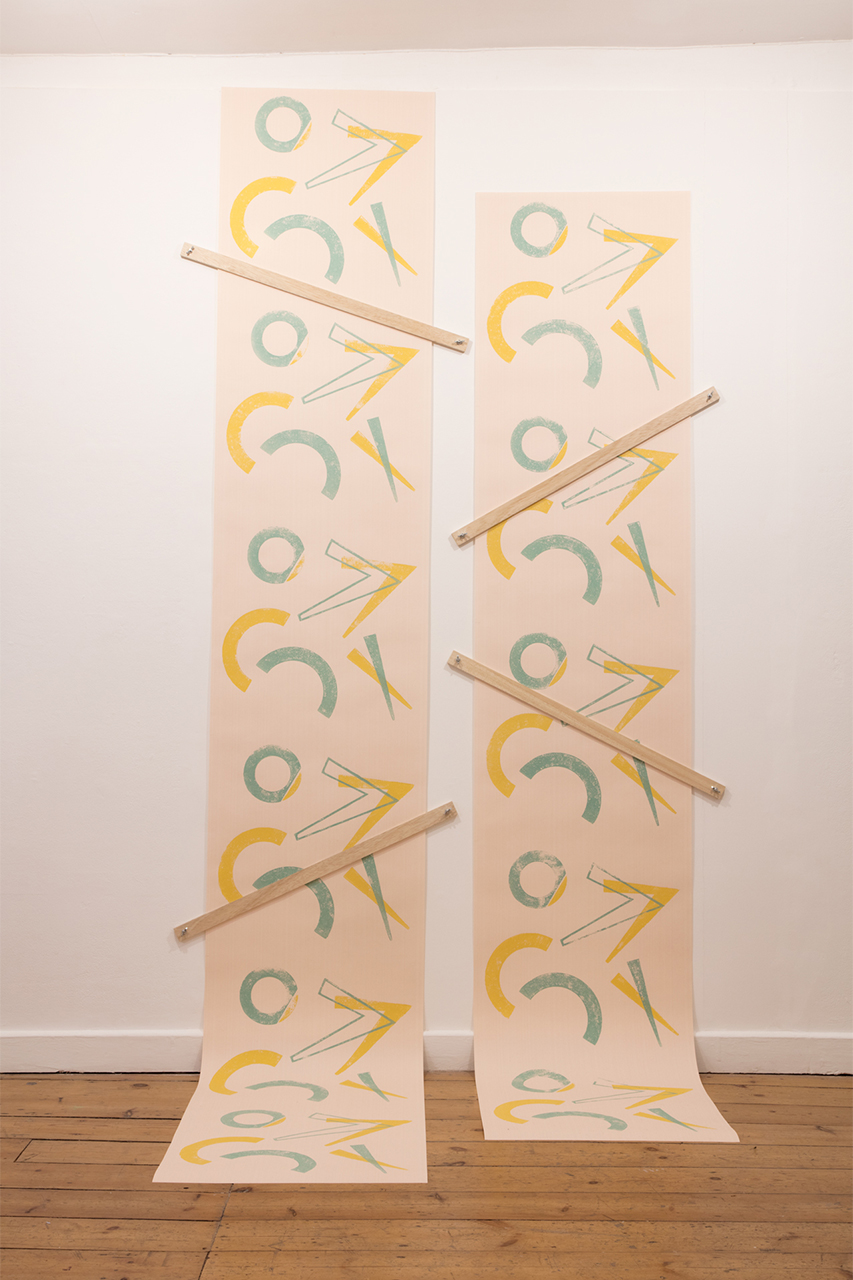Materials of Resistance

Review of Clare Thornton’s solo exhibition, Materials of Resistance, at Plymouth Arts Centre for This is Tomorrow.
In Clare Thornton’s solo exhibition of work
from the last seven years, delicate materials – including the body itself and
those that stand in for it – are put at risk and tested to breaking point.
Thornton has paid precise
attention to the building’s near-domestic scale and architectural quirks. We
are guided up the narrow staircase by handrails adorned with irresistible, pastel-coloured
ceramic bangles, whose inspiration comes from two fearless women of the
avant-garde. Baroness Elsa von Freytag-Loringhoven (1874–1927) wore curtain
rings as bracelets (not to mention hats made of cakes and tomato-tin bras),
while Nancy Cunard (1896–1965), in a Man Ray photograph, is covered with ivory
bangles from wrist to elbow: armature as much as ornament. Thornton interrupts
the continuity of hard, glossy surfaces with a single bracelet of spiked hair:
tactile but defensive. Despite the ceramics’ vulnerability to damage, their location
invites us to touch them, and is a gesture of generosity, trust and acceptance.
The gallery’s stairs become a
place to pause. A chamois leather
punch bag encases the vertical post that the staircase pivots around. It is
both body and costume. Contrasting with the solid coolness typical of a punch
bag, this one seems to have been turned inside out. The soft animal skin offers
a sensuous comfort, but the form is implicit with aggression, conjuring an
image of arms striking out. Its proximity to the fragile ceramics is alarming
and bold.
Upstairs, resting in a corner
on the floor, an extruded earthenware tube – corporeal in scale – loops and
folds over itself. What appears to be a single length is, in fact, three. Their
ends touch but the cuts are decisive and these pieces seem removed from some
larger whole that is not present. Previous works in this series of visceral
forms feature bands and splatters of colour. Now they are pared back to white
and their reticence is unsettling.
Other isolated sections hang
over hand-whittled yew hooks.
Although made with a mechanical extruder, the tubes’ gentle curves seem
tenderly formed, teased into shape by hand. A pinch at the end of one, pinprick
pockmarks interrupting the pristine glaze of another, and the
strong-but-breakable nature of the material itself remind us of their human
quality. Emerging from the end of one tube, a tail of artificial auburn hair
droops, at once elegant and horrifying.
The
falling body is central to an ongoing
collaboration with writer and artist Emma Cocker. In this iteration of The Italic I, two monitors show
slow-shifting, still images of Thornton repeatedly falling to the ground. Words
appear on a third perpendicular screen, like a dance coach side of stage,
calling elliptical instructions to pupils. “It could break at any point”; “Restraint
has positive force, a necessary tension”; “There is a letting go before you let
go”, the screen reads as the figures split, overlap, merge and blur, twisting
into impossible configurations. Devoid of a narrative explanation, each fall is
deliberate and the effect of gravity inevitable.
Thornton’s background in
dance and scenography is evident in the upstairs galleries, where machines are
treated as collaborative performers. In a photographic triptych, dancer Laura
Dannequin interacts with a huge, mechanical wood-block wallpaper press. Her
body dynamically demonstrates the sheer physical labour required to produce a
decorative pattern. The wallpaper itself hangs nearby: two palest-pink strips escape
their designated wall space, intruding on to the floor. Held by butterfly-bolted
white oak batons that transcend functionality, this is wallpaper as sculptural
object. Pairs or doubles or halves are recurring motifs throughout the
exhibition, and here, bisected circles, elongated triangles and V shapes are repeated
in yellow and eau de Nil. From this abstract geometry a fractured figure
appears to be toppling forward, head and limbs detached, the body coming apart.
There are formal parallels in
a neighbouring photograph in which the
artist’s body is draped, face-down over an industrial roll of fabric in a
warehouse. Is she resting, exhausted, or participating in an undefined protest?
Her short-sleeved shirt, polka-dot skirt and trainers contribute to the image’s
absurdity, but also suggest that work can consume the body and mind in numerous
ways. In Modern Times (1936), Charlie Chaplin’s character struggles
to keep up with the speed of an industrial production line, and is swallowed by
a machine’s rotating cogs. While Chaplin is bewildered at his predicament, Thornton’s
seemingly calm demeanour provides a more ambiguous take on where power lies,
and throughout Materials of Resistance, bodies
and materials under strain remind us of the terror and liberation of losing
control.



